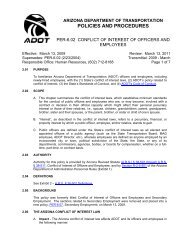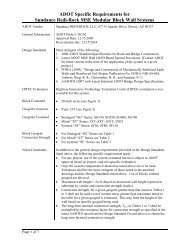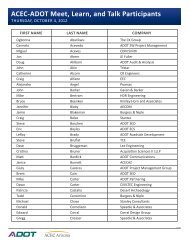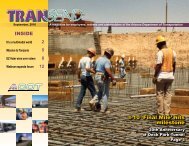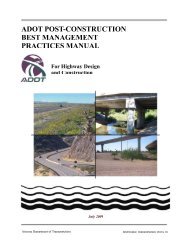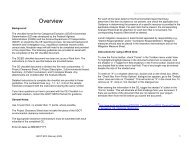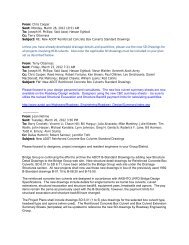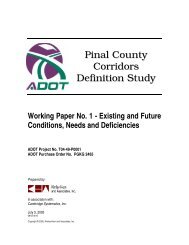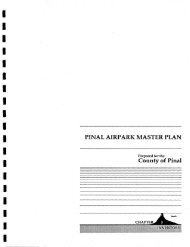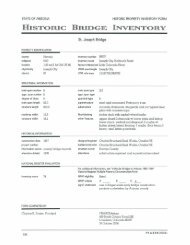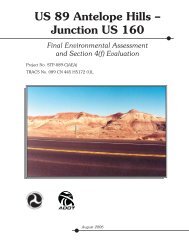I-10 Twin Peaks Traffic Interchange, Environmental Assessment
I-10 Twin Peaks Traffic Interchange, Environmental Assessment
I-10 Twin Peaks Traffic Interchange, Environmental Assessment
You also want an ePaper? Increase the reach of your titles
YUMPU automatically turns print PDFs into web optimized ePapers that Google loves.
Affected Environment and <strong>Environmental</strong> Impacts October 2005<br />
Pacific Pipeline. Subsequently the site was characterized as a large Hohokam<br />
village. Even though the site is on the opposite side of the Santa Cruz River, it may<br />
have been part of the community centered around Los Morteros. During the field<br />
survey conducted for this project, it was noted that a sand and gravel operation that<br />
was redeveloped as the Pines Golf Club at Marana had destroyed the site south of<br />
the Arizona Block and Brick Company parcel. During the course of recording the<br />
Arizona Block and Brick Company building, the crew inspected the parcel. No<br />
artifacts or archaeological features were noted, but more deeply buried<br />
archaeological deposits could remain.<br />
Scatter Of Hohokam Pottery Sherds AZ AA:12:52(ASM)<br />
This site was first recorded in 1958 and described as a scatter of Hohokam pottery<br />
sherds; however, the site was noted as destroyed by construction of the Southern<br />
Pacific Railroad, Casa Grande Highway (State Highway 84), and the Southern<br />
Pacific Pipeline in 1958. I-<strong>10</strong> was subsequently constructed in this corridor as<br />
well.<br />
Disturbed Scatter Of Hohokam Pottery Sherds AZ AA:12:146(ASM)<br />
This site was discovered in 1981 and subsequent testing and data recovery<br />
identified 23 features including pit houses, small pits, roasting pits, rock<br />
concentrations, and a secondary cremation. The site was interpreted as a middle<br />
Sedentary period habitation locus associated with the community centered on Los<br />
Morteros. The site was described as no longer existing prior to construction of the<br />
residential development that covers the former site location.<br />
Extensive And Dense Scatter Of Hohokam Pottery Sherds And Flaked Stone AZ<br />
AA:12:226(ASM)<br />
This site was discovered in the 1980s by the North Tucson Basin Survey, and<br />
described as an extensive and sometimes dense scatter of Hohokam pottery sherds<br />
and flaked stone, along with fire-cracked rock and areas of ash staining. In 2003,<br />
archaeological monitoring of geotechnical testing near the site as part of the I-<strong>10</strong><br />
widening project discovered only a few artifacts. During the field surveys for this<br />
project, it was noted that the scatter extended farther west than originally mapped,<br />
and site boundaries were expanded approximately 3 acres to include the entire<br />
distribution of surface artifacts, increasing the total site area to approximately 24.2<br />
acres.<br />
Large Artifact Scatter And Possible Hohokam Pit House Village AZ<br />
AA:12:227(ASM)<br />
This site was discovered in the 1980s by the North Tucson Basin Survey and a<br />
recent survey inspected the site and reported finding approximately 50 artifacts on<br />
the site surface. Test excavations were recommended to determine if buried<br />
cultural deposits were present and evaluate the National Register eligibility of the<br />
site. During the field surveys for this project, a sample of surface artifacts were<br />
counted and a high density of artifacts at the site was suggested.<br />
Interstate <strong>10</strong> <strong>Traffic</strong> <strong>Interchange</strong> at<br />
<strong>Twin</strong> <strong>Peaks</strong>/Linda Vista<br />
4-69<br />
Project No.: NH-0<strong>10</strong>-D (AIW)<br />
TRACS No.: <strong>10</strong> PM 236 H5838 01D



